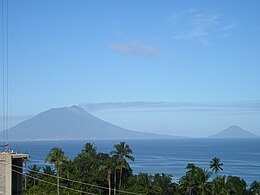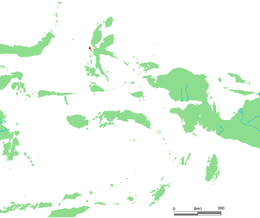Ternate

Ternate Island
|
|
| Geography | |
|---|---|
| Location | South East Asia |
| Coordinates | 0°47′N 127°22′E / 0.783°N 127.367°E |
| Archipelago | Maluku Islands |
| Area | 111.39 km2 (43.01 sq mi) |
| Highest elevation | 1,715 m (5,627 ft) |
| Highest point | Gamalama |
| Administration | |
|
Indonesia
|
|
| Demographics | |
| Population | 185,705 (2010) |
| Pop. density | 1,667 /km2 (4,318 /sq mi) |
Ternate is an island in the Maluku Islands (Moluccas) of eastern Indonesia. It was the center of the former Sultanate of Ternate. It is off the west coast of the larger island of Halmahera. The city has a population of just under 200,000 on some 111.39 km2.
Like its neighbouring island, Tidore, Ternate is a visually dramatic cone-shape. The two are ancient Islamic sultanates (Ternate's Sultanate and Tidore's) with a long history of bitter rivalry. The islands were once the world's single major producer of cloves, a commodity that allowed their sultans to become amongst the wealthiest and most powerful of all sultans in the Indonesian region. In the precolonial era, Ternate was the dominant political and economic power over most of the "Spice Islands" of Maluku.
Today, Ternate City is the largest town in the province of North Maluku, within which the island constitutes a municipality (kotamadya). It is, however, no longer the provincial capital, a title now held by the town of Sofifi on Halmahera.
The "Ternate Essay" was a pioneering account of evolution by natural selection written on the island by Alfred Russel Wallace in 1858 and famously sent to Charles Darwin. Darwin at once responded by publishing Wallace's essay alongside his own accounts of the theory.
Ternate is dominated by the volcanic Mount Gamalama (1715 m). An 1840 eruption destroyed most houses. Recent eruptions occurred in 1980, 1983, 1994 and 2011. During the 2011 eruption, Indonesia closed a domestic airport near the volcano for several days following ash emissions that reached 2,000 metres (6,600 feet) into the atmosphere.
...
Wikipedia

